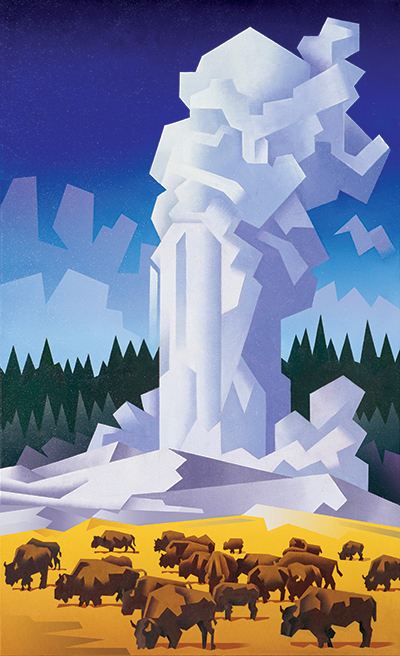Grazing buffalo are utterly unmoved by an erupting Yellowstone geyser in Geyser w: Bison (below), a 37-by-23-inch oil-on-canvas by northern California–based painter David Jonason. The work is the artist’s tribute to “America’s great mammal.” To him a bison “is like a big pile of rocks”—and he means that as a sincere compliment.
“I love the land so much,” Jonason says. “I even see a picture of a pile of rocks, and my heart begins to beat.…All those red rocks and big skies.” His fascination with the American Western landscape began on family outings to California’s Mojave and Anza-Borrego deserts. “When I was a kid, we’d go out to the desert and look for rocks,” he says, “so I’ve always loved it.”
 The artist’s focus of late has been on Wyoming, specifically the Teton Range and Yellowstone. Jonason is represented at Big Horn Galleries in Cody and Mountain Trails Gallery in Jackson. He’s also a frequent participant in the annual art show and sale at the Buffalo Bill Center of the West in Cody. “At a lot of the gallery shows they want things that are in their region,” he says. “In Arizona they want Monument Valley. In New Mexico they want Bandolier, Taos Gorge, stuff like that. I try to do things that are local, and that got me into this area of doing bison and geysers.”
The artist’s focus of late has been on Wyoming, specifically the Teton Range and Yellowstone. Jonason is represented at Big Horn Galleries in Cody and Mountain Trails Gallery in Jackson. He’s also a frequent participant in the annual art show and sale at the Buffalo Bill Center of the West in Cody. “At a lot of the gallery shows they want things that are in their region,” he says. “In Arizona they want Monument Valley. In New Mexico they want Bandolier, Taos Gorge, stuff like that. I try to do things that are local, and that got me into this area of doing bison and geysers.”
Jonason was born in Presque Isle, Maine, right along the Canadian border, and he has been illustrating since old enough to hold a pen or a brush. A kindergarten art project cemented his fascination with art. “I did this self-portrait in my plaid shirt and glasses and had all the details, and I got all kinds of praise from my class and my teacher,” he says. “From then on I was just a sap for being praised.”
After college he moved with his wife and infant son to “an old, broken-down plantation” that his “eccentric” parents were renovating in the West Indies. Living in an outbuilding, he beefed up his portfolio designing brochures and menus for island restaurants before returning stateside four years later. After freelancing for newspapers and magazines, he landed an artist position with ABC’s World News Tonight. “We’d do lot of maps,” he recalls. “If there was an airline crash, you’d have to do a quick illustration or cutaway of an airplane. Maps of Lebanon with explosions on it. You’d do all that kind of stuff, and they’d put it up on the box above Peter Jennings’ head.”
But Jonason eventually wearied of such collaborative work and graphics most people wouldn’t consider art. On hiring an agent, he began picking up freelance assignments, and in 1993 he moved to Galisteo, N.M. After the dissolution of his marriage and the national trauma of 9/11 he started painting. It proved cathartic. “I think a lot of illustrators, if you scratch the surface, want to be painters,” he says. “I started to do fewer assignments and more paintings, a couple of galleries picked me up, and Southwest Art did an article on me. All of a sudden I have a career and get to paint every day.”
Such work is not for everyone, he concedes. “It’s one of those really weird professions where you’re not guaranteed anything,” he says. “You’re working on a project that’s very challenging, and you have to get up and really hit it hard every day. It takes nerve.”
Jonason is busy rendering works for “Southwestern Synergy,” a November 8 show at Manitou Galleries’ Canyon Road space in Santa Fe. Given his focus on local subjects, don’t expect to find bison or geysers. Anyway, the artist is always looking for new subjects and new challenges while pursuing modernist interpretations of Western themes.
“You don’t want to be a prisoner of your past successes,” Jonason explains. “You want to try to keep it moving, break out of the box and not be a prisoner of your style. That’s always part of the challenge. But I love the American West.” WW





